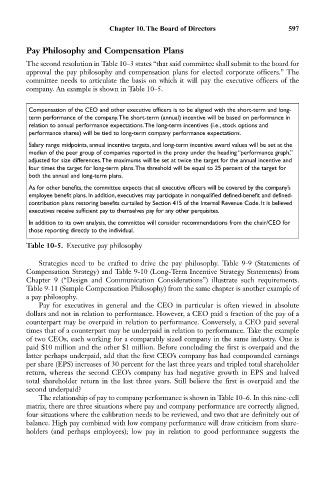Page 611 - Bruce Ellig - The Complete Guide to Executive Compensation (2007)
P. 611
Chapter 10. The Board of Directors 597
Pay Philosophy and Compensation Plans
The second resolution in Table 10–3 states “that said committee shall submit to the board for
approval the pay philosophy and compensation plans for elected corporate officers.” The
committee needs to articulate the basis on which it will pay the executive officers of the
company. An example is shown in Table 10–5.
Compensation of the CEO and other executive officers is to be aligned with the short-term and long-
term performance of the company.The short-term (annual) incentive will be based on performance in
relation to annual performance expectations.The long-term incentives (i.e., stock options and
performance shares) will be tied to long-term company performance expectations.
Salary range midpoints, annual incentive targets, and long-term incentive award values will be set at the
median of the peer group of companies reported in the proxy under the heading “performance graph,”
adjusted for size differences.The maximums will be set at twice the target for the annual incentive and
four times the target for long-term plans.The threshold will be equal to 25 percent of the target for
both the annual and long-term plans.
As for other benefits, the committee expects that all executive officers will be covered by the company’s
employee benefit plans. In addition, executives may participate in nonqualified defined-benefit and defined-
contribution plans restoring benefits curtailed by Section 415 of the Internal Revenue Code. It is believed
executives receive sufficient pay to themselves pay for any other perquisites.
In addition to its own analysis, the committee will consider recommendations from the chair/CEO for
those reporting directly to the individual.
Table 10-5. Executive pay philosophy
Strategies need to be crafted to drive the pay philosophy. Table 9-9 (Statements of
Compensation Strategy) and Table 9-10 (Long-Term Incentive Strategy Statements) from
Chapter 9 (“Design and Communication Considerations”) illustrate such requirements.
Table 9-11 (Sample Compensation Philosophy) from the same chapter is another example of
a pay philosophy.
Pay for executives in general and the CEO in particular is often viewed in absolute
dollars and not in relation to performance. However, a CEO paid a fraction of the pay of a
counterpart may be overpaid in relation to performance. Conversely, a CEO paid several
times that of a counterpart may be underpaid in relation to performance. Take the example
of two CEOs, each working for a comparably sized company in the same industry. One is
paid $10 million and the other $1 million. Before concluding the first is overpaid and the
latter perhaps underpaid, add that the first CEO’s company has had compounded earnings
per share (EPS) increases of 30 percent for the last three years and tripled total shareholder
return, whereas the second CEO’s company has had negative growth in EPS and halved
total shareholder return in the last three years. Still believe the first is overpaid and the
second underpaid?
The relationship of pay to company performance is shown in Table 10–6. In this nine-cell
matrix, there are three situations where pay and company performance are correctly aligned,
four situations where the calibration needs to be reviewed, and two that are definitely out of
balance. High pay combined with low company performance will draw criticism from share-
holders (and perhaps employees); low pay in relation to good performance suggests the

